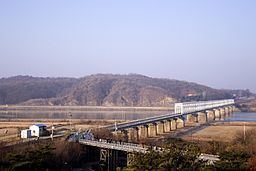Length 254 km Source Masiknyeong Mountain Pass | ||
 | ||
- location | ||
Britains bloodiest post wwii battle imjin river
The Imjin River (Hangul: 임진강 in South Korea) or Rimjin River (Chosŏn'gŭl: 림진강 in North Korea) is the 7th largest river in Korea. It flows from north to south, crossing the Demilitarized Zone and joining the Han River downstream of Seoul, near the Yellow Sea. The river is not the namesake of the Imjin Waeran Japanese invasions of Korea in the late 16th century.
Contents
- Britains bloodiest post wwii battle imjin river
- Map of Rinsin Ko Tanhyeon myeon Paju si
- Imjin documentary on the korean war battle of imjin river
- History
- Characteristics
- In popular culture
- References
Map of Rinsin Ko, Tanhyeon-myeon, Paju-si
Imjin documentary on the korean war battle of imjin river
History
The Rimjin River was the site of two major battles: The Battle of the Imjin River during the Seven-Year War in 1592, and the Battle of the Imjin River that took place during the Korean War.
Characteristics
The active channel of the Rimjin River utilizes only about 150 to 200 feet of the 1,200-foot (370 m) width of the dry riverbed that it runs through, which is bordered by almost vertical rock cliffs standing approximately 75 feet (23 m) above the mean low water level. It gives no indication in normal times of the tremendous power it develops when in flood. During the Korean rainy season of July and August, the Imjin becomes a raging torrent, largely confined by its steep rocky banks. Fed by its larger tributaries and many small mountain streams, it reaches flood heights of 48 feet (15 m) above mean water level and a velocity of 15 to 20 feet per second (6 m/s). The rapid runoff of approximately 95 percent of precipitation during heavy general rains has caused the Imjin, on occasion, to rise at a rate of more than six feet per hour.
During the severe Korean winter, icy winds sweep down the Imjin; the sub-zero temperatures cause thick ice to form on the river. Fluctuations in the level of the river, particularly tidal action in the lower reaches, break up this ice, and large amounts of floe ice pile up against any obstacle in the channel.
The Imjin has been nicknamed by many in South Korea as the "River of the Dead" due to large numbers of dead bodies that have, in the past, floated down it from the North. The most recent occurrence was during the major famine of the 1990s when millions of North Koreans are believed to have starved to death.
In popular culture
In the popular novel "MASH - a novel about three army doctors", the MASH 4077 unit is located close to a branch of the Imjin river.
The Rimjin is the subject of a famous north Korean popular song, Rimjingang, named after the river. It was composed in 1957 with lyrics written by North Korean poet Pak Se-yong. It is a well-known forbidden song in North Korea, as it refers to the Rimjin River as a symbol of freedom flowing from north to south. This song depicts the sadness of a divided homeland and alludes to the infamous history of the river. The song later became popular in Japan when it was covered by The Folk Crusaders.
